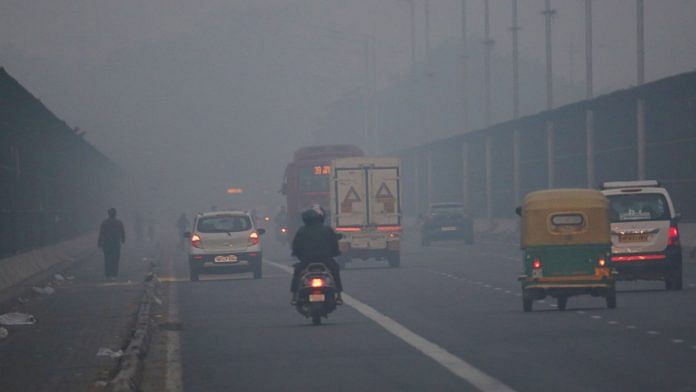New Delhi: Delhi continues to reel under severe air pollution, with a thick blanket of smog over the national capital city. The air quality index (AQI) of the city has crossed the 600-mark, which is considered ‘severe’.
In episode 614 of ‘Cut the Clutter’, ThePrint’s Editor-in-Chief Shekhar Gupta explains the various factors behind Delhi’s poor AQI and also the ongoing tussle between the central and Punjab governments.
“One reason this problem (Delhi air quality) is defying a solution year after year is because this also suffers from the Rashomon effect — how one situation can be described differently by different witnesses, depending on a witness’ own predilections or prejudices,” Gupta said.
He added, “Every time air quality drops, each one of us goes after our favorite targets — diesel, all motor vehicles, even-odd masks, stubble burning in Punjab etc.”
The problem is much larger and complex, not restricted to the Delhi-NCR region, Gupta said. In the list of 20 most polluted cities in the world, India has 15 of them at any given point — they go as far as Varanasi and deep inside Madhya Pradesh. The South Asian subcontinent is badly affected by its air quality throughout the year. That has to do with geography and meteorology, that you cannot change, said Gupta.
Also read: Delhi stares at grim Covid scenario ahead of Diwali — deaths rising, 50% hospital beds full
IIT-Kanpur study
Gupta said that air pollution is a problem that afflicts all of the North Indian plains. So unless this issue is addressed as one, it cannot be resolved.
A report by IIT Kanpur reveals that the issue of bad air quality in Delhi and North India is much more complicated. The researchers chose six different spots in Delhi and measured pollution levels here. They found that at various points of time in a year, the air quality can be 18 times worse, seven times worse or 4-5 times worse in these areas.
“In terms of an annual average of 365 days, Delhi’s air quality is five times worse than the worst air quality that is considered safe for human beings. So if the limit to what is safe or not too dangerous is 100, then Delhi’s average is 500 over 365 days,” Gupta said.
Lahore’s AQI is much worse than Delhi because the weather pattern is different and stubble burning starts earlier there.
The IIT-Kanpur study also noted that in summer, the large-sized particles, i.e. SPM (suspended particulate matter) 10 is at the level of 500 in Delhi — 52 per cent of it is fly ash and dust — whereas the expected level shouldn’t be more than 100.
Stronger summer winds churn up dust and fly ash. Wind directions in winter are different, so we don’t see as much fly ash, but in summers they choke our lungs.
The scientists also analysed the large particles and found that these are filled with silicon, alumina and iron, all of which are harmful. A big amount of these large particles in the summer is what is called crustal (they come from the crust of the soil and include dust, fly ash, etc).
In winter, the crustal matter is much less (only 13 per cent) in North India’s pollution due to less dust and fly ash. The study also said that it comes from burning 26 per cent of what is called secondary particle combustion, which means burning garbage, leaves and municipal solid waste. Only 2-3 per cent of Delhi’s municipal waste is burnt, which then adds to the secondary particle pollution in winter. A lot of this is in the form of carbon and nitrous oxide.
Dust only contributes to 3.5 per cent of the small particle pollution in winters in North India and Delhi. Around 28 per cent also comes from secondary particles, essentially from burning, of which quite a bit comes from stubble burning.
Another 28 per cent secondary particles come from burning, 26 per cent is combustion-related carbon and 7 per cent municipal solid waste. Together, these come down to about 60 per cent.
“The report has 11 specific suggestions. If you follow those, then there are chances of the air quality getting better,” Gupta said.
The study said that during Diwali, not only do SPM level double but the levels of barium and potassium also go up 10 times.
Tug of war between Centre & Punjab
“History tells you that Punjab has a very strong regional impulse. There is no way any central government can arm twist Punjab into doing anything,” Gupta said.
He added, “Punjab farmers are agitating against the new farm laws and blockading trains. After a while, they said they will relent and let goods trains pass. Central law says that railways are a federal property and so unless all trains are safe to come to Punjab, we won’t send selectively.”
Punjab was the cradle of the green revolution in India — new methods of agriculture, hybrids and was also home to the country’s paddy revolution.
“You cannot sell reforms to Punjab farmers by arm twisting them, not at the point of a blockade. Punjabi farmers know how to fight,” Gupta said, citing the Colonisation Bill the British came up with in 1906.
The bill gave the government the authority to confiscate land of any farmer in Punjab who died without an heir. A big agitation called ‘Pagri Sambhal Jatta’ followed. This movement was led by Lala Lajpat Rai and Ajit Singh, both of whom were sent to exile in Mandalay. Still the Punjabi farmers kept fighting.
Watch the latest episode of CTC here:
Also read: What CDS Rawat’s speech tells us about China threat & India’s response to it






